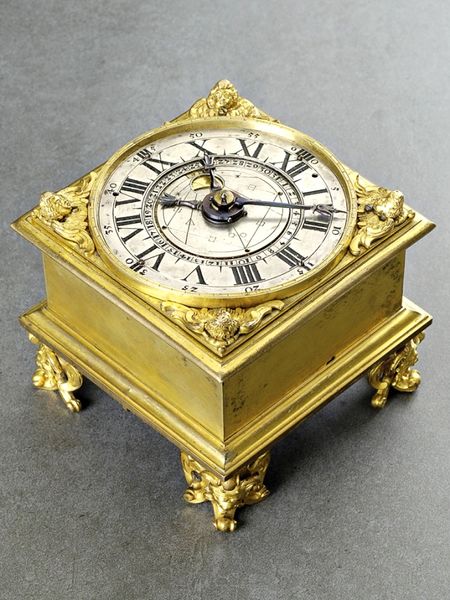Datei:Johann Sayller, Ulm, circa 1630 (1).jpg

Originaldatei (640 × 853 Pixel, Dateigröße: 230 KB, MIME-Typ: image/jpeg)
Johann Sayller, Ulm, 124 x 124 x 115 mm, circa 1630

|
Alle Bildrechte liegen bei dem Auktionshaus Auktionen Dr. H. Crott. Diese Abbildung ist urheberrechtlich geschützt und steht nicht unter einer freien Lizenz. Für anderweitige Nutzungen außerhalb von Watch-Wiki ist die schriftliche Zustimmung des Urheberrechtsinhabers nötig. |
Museale, astronomische, quadratische Horizontaltischuhr mit Viertelstunden-/Stundenselbstschlag, Datum, Mondalter und Mondphase
Geh.: feuervergoldetes Messinggehäuse auf vier mit Bocksköpfen und Voluten verzierten Füßen, 2 Bodenglocken. Ziffbl.: Messing, feuervergoldet, in den Ecken vier gegossene, geflügelte Cherubsköpfe; aufgelegter silberner Stundenziffernring, aufgelegter Datumsring, im Zentrum silberne Scheibe mit bogenförmigem Fensterausschnitt für vergoldeten Mondalterring und Öffnung für Mondphase; graviertes Aspektenschema im Zentrum. Werk: quadratisches Messingwerk, feuervergoldet, Kette/Schnecke, 2 Federhäuser für Stunden- und Viertelstundenschlag, 2 gravierte Hämmer, Schlossscheibe, Spindelhemmung, gebläute Stahl-Ringunruh.
Eine nahezu identische Horizontaltischuhr ist abgebildet und beschrieben in: H.M. Vehmeyer "Clocks their origin and development 1320-1880", Band I, Wilsele 2004, Seite 140f.
A square astronomical table clock of museum quality, with quarter hour / hour strike, date, moon age and moon phase Case: firegilt brass case on four feet ornamented with goats heads and volutes, 2 rear bells. Dial: brass, firegilt, cast cherubs heads to the corners; applied silver date ring within a silver chapter ring; next to it, a gilt brass moon-age ring attached to a disc with a moon phase aperture; an engraved aspect scheme in the centre. Movm.: square brass movement, firegilt, chain/fusee, 2 barrels for hour and quarter hour strike, 2 engraved hammers. locking plate, verge escapement, blued steel ring balance.
Johann Sayller (1594-1668) was born in Angelberg in the diocese of Freising, Lower Bavaria and was one of the most renowned makers of complicated watch and clocks in the 17th century. Johann Sayller settled in Ulm in 1617 and became a citizen in 1624; in 1646 he became guild master. Sayller created his master piece in 1626: a rolling ball clock after Margraf, which was first exhibited in the town hall of Ulm and from 1812 on in the private library of King Frederick I of Württemberg. Sayller’s pieces were so superior and sought after that they were mostly used as gifts for important and famous people. He created precious pendant watches, complicated astronomical bracket clocks and other technically sophisticated pieces. Two of his rolling ball clocks and a silver astronomical tower-shaped bracket clock with a three months power reserve are in the posession of the Württembergisches Landesmuseum. Other table clocks of Sayller can be found in museum collections around the world,including the National Museum in Copenhagen, the Kunsthistorisches Museum in Vienna, and the Los Angeles County Museum of Art. Source: http://www.uhrenhanse.org/sammlerecke/portraits/namen/name_s.htm, as of 01/22/2015
A nearly identical table clock is illustrated and described in: H.M. Vehmeyer "Clocks their origin and development 1320-1880", vol. I, Wilsele 2004, page 140f.
Dateiversionen
Klicke auf einen Zeitpunkt, um diese Version zu laden.
| Version vom | Vorschaubild | Maße | Benutzer | Kommentar | |
|---|---|---|---|---|---|
| aktuell | 16:33, 2. Apr. 2019 |  | 640 × 853 (230 KB) | Andriessen (Diskussion | Beiträge) | Johann Sayller, Ulm, 124 x 124 x 115 mm, circa 1630 {{Bildrechte U|dem Auktionshaus Auktionen Dr. H. Crott}} {{Kategorie Bildgalerie Uhrenmodelle Sayller (Sayler, Sailer, Seyller), Johannes (1597-1668)}} Museale, astronomische, quadratische Horiz… |
Du kannst diese Datei nicht überschreiben.
Dateiverwendung
Die folgende Seite verwendet diese Datei:
- Bildgalerie Uhrenmodelle Sayller (Sayler, Sailer, Seyller), Johannes (1597-1668)
- Picture gallery watch models Sayller (Sayler, Sailer, Seyller), Johannes (1597-1668)
- Galería de imagenes de modelos de relojes Sayller (Sayler, Sailer, Seyller), Johannes (1597-1668)
- Afbeeldingen galerij uurwerkmodellen Sayller (Sayler, Sailer, Seyller), Johannes (1597-1668)
- Фотогалерея Модели часов Sayller (Sayler, Sailer, Seyller), Johannes (1597-1668)
- Galleria fotografica di modelli orologi Sayller (Sayler, Sailer, Seyller), Johannes (1597-1668)